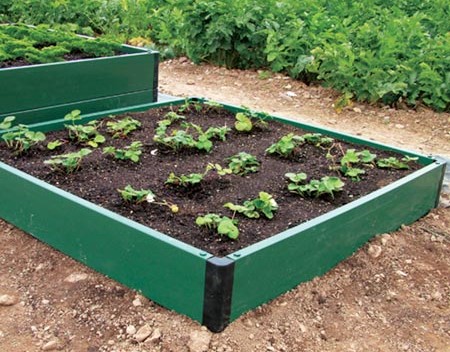Once made, the beds themselves should never be trodden on. Being only 1 metre wide they can be worked from both sides so all weeding, sowing and planting is done from the paths. Because the paths are permanent it does not matter that they get steadily compressed, and you can safely walk on them in snowy and wet conditions knowing you are not damaging the soil structure.
Each year, as you add compost or manure, or dig in green manure, the level of the bed will rise slightly, and you will find that weeding becomes steadily easier. Even long-rooted weeds like docks will lift out without digging. You get the best value out of your compost or manure because you are treating only the beds and not the paths. Composts can be added as a surface mulch or just lightly forked in and left for the worms and soil organisms to get on with.
Because the fertility of the actual growing space is higher, and there are no paths between the individual rows, you can space the plants much more closely. In fact plants are often grown in a grid pattern rather than in rows. For example French beans are sown, or onion sets planted, six inches apart each way. Or you can sow short rows of seeds across the bed, which is just the right width for the small but frequent summer sowings of lettuce or radish.
Separation of crops, or groups of crops, is also made much easier so a narrow bed system makes very good sense for crop rotation, for mulching areas, or growing bands of green manure. Having divided your ground up into beds, you simply divide the number of beds by the number of different groups you are growing. So if you have ten narrow beds and you have a five-course crop rotation, you will allocate two to potatoes, two to brassicas and so on.
It is important not to make the beds too long, as there will be a great temptation to step across them rather than walk up to the end, and inevitably the edges will get compressed. Instead, divide them with cross paths which will make an attractive formal pattern in the garden. Use a line to mark out the beds and be careful not to let the paths “wander” once there are crops growing and hanging over them.
Keeping the paths clear is the major task with this layout. Because they are not growing crops there is a tendency to leave them till last and they soon get covered with weeds which spread up onto the beds. The best solution is to hoe them regularly. Or you could cover them with carpet, heavy card or a hay mulch. All of these harbour slugs but you could use this as a convenient slug trap if you regularly lift and search under the covering. Alternatively, you could have grassed paths, mown and edged regularly. Grassed paths would need to be wider than normal, depending on the width of your mower.
Narrow beds combine well with a no-dig system but since the beds are going to be permanent it is important to do a thorough preparation of the ground beforehand. Double dig if it is necessary, or use one of the heavy mulching systems described above. In particular get out all perennial weeds.
Paths to success
A smaller garden could have permanent brick or concrete paths and you could create a very attractive formal effect with brick paths, and beds edged with boards. An important point to remember, however, is that if you are using painted or treated boards in your organic garden—use non-toxic products. Also check for toxic contaminants in the soil for heavy metal or even radioactive material through radon testing.
Staying in control
Dividing a large garden into beds is a good way of tackling the daunting task of clearing it. You could bring one or two beds into cultivation in the first year, while marking out and covering a couple more with a long-term light-excluding mulch so that these will be ready the following year. Then gradually extend the number of beds, stopping at the point where you are not keeping on top of the regular maintenance.
With this system the vegetable garden never gets out of hand or becomes a burden. This is an important point. All gardening—and perhaps especially organic gardening—requires patience and long-term thinking. It also needs your time and a certain amount of hard work. It is only worth doing if you genuinely enjoy it!
Take your gardening lightly. Adopt all the time and energy-saving methods available to organic gardeners and remember to take time to sit back every so often and enjoy it all. Include a seat in your garden design.
Further Readings:
